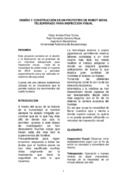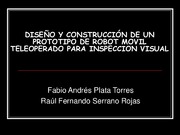Mostrar el registro sencillo del ítem
Diseño y construcción de un prototipo de robot móvil teleoperado para inspección visual
| dc.contributor.advisor | Chio Chio, Nayibe | spa |
| dc.contributor.author | Plata Torres, Fabio Andrés | spa |
| dc.contributor.author | Serrano Rojas, Raúl Fernando | spa |
| dc.date.accessioned | 2020-06-26T19:45:12Z | |
| dc.date.available | 2020-06-26T19:45:12Z | |
| dc.date.issued | 2006 | |
| dc.identifier.uri | http://hdl.handle.net/20.500.12749/1526 | |
| dc.description.abstract | A través del curso de la historia de la humanidad el hombre siempre ha estado intrigado por conocer que es lo que hay mas allá de donde sus ojos lo permiten, gracias a este deseo de investigación se han descubierto muchas cosas que hacen cada día mas fácil la supervivencia del hombre. Frecuentemente para lograr encontrar respuesta a todas las dudas que el hombre posee se han visto sacrificado muchas vidas originando así la importancia que tiene la seguridad en todo lo que hacemos. La tecnología avanza a pasos gigantescos permitiendo realizar labores complejas a un nivel mucho más fácil, los robots facilitan el trabajo peligroso o donde se requiere grandes aplicaciones de fuerza lo que implica gran cantidad de hombres al realizar un trabajo. Tomando las diferentes tecnologías como lo son la de las telecomunicaciones, la informática y la robótica se han desarrollado robots capaces de ser teleoperados desde sitios más seguros con el fin de no detener la carrera evolutiva del hombre. Es así que surge la necesidad de llevar nuestros ojos y mente a donde nuestro cuerpo no quiere o no puede acceder utilizando un microbot de inspección visual. | spa |
| dc.description.tableofcontents | INTRODUCCIÓN 10 1. GENERALIDADES 11 1.1 PLANTEAMIENTO DEL PROBLEMA Y JUSTIFICACIÓN 11 1.2 OBJETIVOS 1.2.1 OBJETIVO GENERAL 12 1.2.2 OBJETIVOS ESPECÍFICOS 12 1.3 MARCO TEORICO 13 1.3.1 MEDIOS DE COMUNICACIÓN INALÁMBRICA 13 1.3.1.1 RADIO FRECUENCIA 13 1.3.1.2 MICROONDAS 14 1.3.1.3 REDES INFRARROJAS 15 1.3.2 ANTENAS 17 1.3.3. MODULACIÓN ASK (AMPLITUDE SHIFT KEYING) 23 1.3.4. ROBOTS MÓVILES 28 1.3.4.1 VEHÍCULOS CON RUEDAS 28 1.3.4.1.1. ACKERMAN 29 1.3.4.1.2. TRICICLO CLÁSICO 30 1.3.4.1.3. DIFERENCIAL 31 1.3.4.2. MODELOS CINEMÁTICOS DE ROBOTS MÓVILES 32 1.3.4.2.2. CONSIDERACIONES DEL ANÁLISIS 32 1.3.4.2.3. RESTRICCIONES CINEMÁTICAS 32 1.3.4.3. MODELO JACOBIANO 37 1.3.4.4. MODELOS DE DIFERENTES CONFIGURACIONES 40 1.3.4.5 ESTIMACIÓN DE LA POSICIÓN Y ORIENTACIÓN 45 2. DISEÑO 47 2.1 FASES DEL DISEÑO 48 2.2. PC – CARVISION V.1.0 49 2.2.1. DISEÑO DEL SOFTWARE 49 2.2.1.1 INTRODUCCIÓN AL NEOBOOK 50 2.2..1.2. SOFTWARE CARVISION V.1 52 2.2.1.3. DESCRIPCIÓN DEL CARVISION 1.0 53 2.2.1.4 ELABORACIÓN DE CARVISION 1.0 55 2.2.1.5. PROGRAMACIÓN DEL CARVISION 1.0 56 2.3. MODULO EMISOR 62 2.3.1 CRITERIOS DE SELECCIÓN DEL MICROCONTROLADOR 63 2.3.2. PROGRAMACIÓN DEL MICROCONTROLADOR. 63 2.3.2.1. CÓDIGO FUENTE DEL PROGRAMA. 65 2.4 MÓDULO TRANSMISOR 67 2.5. MÓDULO RECEPTOR 67 2.6 MODULO RECEPTOR. 69 2.6.1. CÓDIGO FUENTE Y DETALLE DE SUBRUTINAS (CÓDIGO FUENTE) 0 70 2.7 SENSORES DEL MICROBOT 77 2.7.1 SENSOR DE PROXIMIDAD A OBJETOS Y HUECOS 77 2.7.2 SENSOR AUTOMÁTICO DE LUZ 79 2.8 DISEÑO MECÁNICO DEL MICROBOT 80 2.8.1 SELECCIÓN DEL TIPO DE MOVIMIENTO. 80 2.8.2 MODELADO DEL SISTEMA 81 2.8.3 ANÁLISIS DEL RADIO DE GIRO 82 2.8.3.1 GIRO SOBRE SI MISMO 83 2.8.4 AVANCE RECTO 84 2.8.5 ECUACIONES PARA EL ANÁLISIS DE TRAYECTORIAS. 84 2.8.6 SIMULACIÓN 86 2.9 SELECCIÓN DE MOTORES ELÉCTRICOS DC 88 2.9.1 PRUEBAS AL MINIMOTOR 89 2.10 ANÁLISIS FÍSICO DE FUERZAS Y ENERGÍA 91 2.10.1. ANÁLISIS EN PLANO HORIZONTAL 91 2.10.2. ANÁLISIS EN PLANO INCLINADO 94 2.10.3. LIMITACIONES DE AVANCE DEL MICROBOT. 95 2.11. DISEÑO FINAL 97 2.12 SELECCIÓN DE LA CÁMARA INALÁMBRICA 100 2.12.1 ESPECIFICACIONES DE LA CÁMARA 100 2.12.2. ESPECIFICACIONES DEL RECEPTOR 101 2.13 DISEÑOS DE CIRCUITOS ELECTRÓNICOS. 102 3.0 CONCLUSIONES Y RECOMENDACIONES 103 4.0 BIBLIOGRAFÍA 105 5.0 ANEXOS 107 | spa |
| dc.format.mimetype | application/pdf | spa |
| dc.language.iso | spa | spa |
| dc.rights.uri | http://creativecommons.org/licenses/by-nc-nd/2.5/co/ | * |
| dc.title | Diseño y construcción de un prototipo de robot móvil teleoperado para inspección visual | spa |
| dc.title.translated | Design and construction of a prototype of a teleoperated mobile robot for visual inspection | eng |
| dc.degree.name | Ingeniero Mecatrónico | spa |
| dc.coverage | Bucaramanga (Colombia) | spa |
| dc.publisher.grantor | Universidad Autónoma de Bucaramanga UNAB | spa |
| dc.rights.local | Abierto (Texto Completo) | spa |
| dc.publisher.faculty | Facultad Ingeniería | spa |
| dc.publisher.program | Pregrado Ingeniería Mecatrónica | spa |
| dc.description.degreelevel | Pregrado | spa |
| dc.type.driver | info:eu-repo/semantics/bachelorThesis | |
| dc.type.local | Trabajo de Grado | spa |
| dc.type.coar | http://purl.org/coar/resource_type/c_7a1f | |
| dc.subject.keywords | Industrial robots | eng |
| dc.subject.keywords | Prototype development | eng |
| dc.subject.keywords | Mechatronic Engineering | eng |
| dc.subject.keywords | Design and construction | eng |
| dc.subject.keywords | Investigations | eng |
| dc.subject.keywords | Analysis | eng |
| dc.subject.keywords | Manipulators | eng |
| dc.subject.keywords | Robotics | eng |
| dc.subject.keywords | Product development | eng |
| dc.identifier.instname | instname:Universidad Autónoma de Bucaramanga - UNAB | spa |
| dc.identifier.reponame | reponame:Repositorio Institucional UNAB | spa |
| dc.type.hasversion | info:eu-repo/semantics/acceptedVersion | |
| dc.rights.accessrights | info:eu-repo/semantics/openAccess | spa |
| dc.rights.accessrights | http://purl.org/coar/access_right/c_abf2 | spa |
| dc.relation.references | Plata Torres, Fabio Andrés, Serrano Rojas, Raúl Fernando (2006). Diseño y construcción de un prototipo de robot móvil teleoperado para inspección visual. Bucaramanga (Colombia) : Universidad Autónoma de Bucaramanga UNAB | spa |
| dc.contributor.cvlac | https://scienti.minciencias.gov.co/cvlac/visualizador/generarCurriculoCv.do?cod_rh=0000375918 | * |
| dc.contributor.googlescholar | https://scholar.google.es/citations?hl=es&user=mModWy8AAAAJ | * |
| dc.contributor.orcid | https://orcid.org/0000-0002-9459-4350 | * |
| dc.contributor.researchgate | https://www.researchgate.net/profile/Nayibe_Chio | * |
| dc.subject.lemb | Robots industriales | spa |
| dc.subject.lemb | Desarrollo de prototipos | spa |
| dc.subject.lemb | Ingeniería mecatrónica | spa |
| dc.subject.lemb | Diseño y construcción | spa |
| dc.subject.lemb | Investigaciones | spa |
| dc.subject.lemb | Análisis | spa |
| dc.description.abstractenglish | Throughout the course of human history, man has always been intrigued to know what lies beyond his eyes, thanks to this desire for research, many things have been discovered that make life easier every day. survival of man. Frequently, in order to find an answer to all the doubts that man has, many lives have been sacrificed, thus originating the importance of security in everything we do. Technology advances in gigantic steps allowing complex tasks to be carried out at a much easier level, robots facilitate dangerous work or where large applications of force are required, which implies a large number of men when carrying out a job. Taking different technologies such as telecommunications, computer science and robotics, robots capable of being teleoperated from safer places have been developed in order not to stop the evolutionary race of man. Thus, the need arises to take our eyes and mind to where our body does not want or cannot access using a visual inspection microbot. | eng |
| dc.subject.proposal | Manipuladores | |
| dc.subject.proposal | Robótica | |
| dc.subject.proposal | Desarrollo de productos | |
| dc.subject.proposal | Software | |
| dc.type.redcol | http://purl.org/redcol/resource_type/TP | |
| dc.rights.creativecommons | Atribución-NoComercial-SinDerivadas 2.5 Colombia | * |
| dc.contributor.researchgroup | Grupo de Investigación Control y Mecatrónica - GICYM | spa |
| dc.contributor.researchgroup | Grupo de Investigaciones Clínicas | spa |
| dc.coverage.campus | UNAB Campus Bucaramanga | spa |
| dc.description.learningmodality | Modalidad Presencial | spa |




